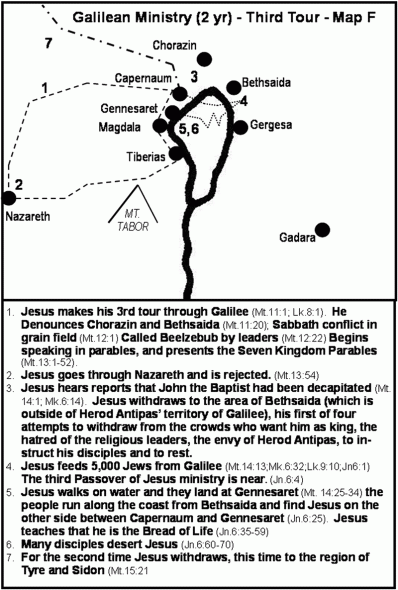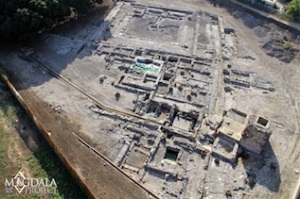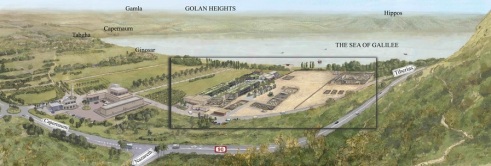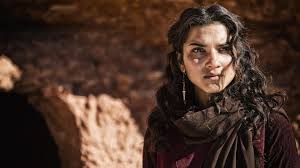We have walked with these women and Jesus, finding out about His love for them, watching Him perform miracles in their lives, and seeing their response to Him. We have heard time and again that Jesus gives dignity to women, and Mary’s life is one of the best examples of this!
What do we know about Mary?
When I first started researching Mary this summer, I thought I would have nothing to write because there’s so little written about her. Boy was I wrong!
Mary was a Jewish woman living in the region of Galilee in a city named Magdala.
It was located on the western shore of the Sea of Galilee. Josephus, a Jewish historian during the 1st century, wrote about Magdala as being a fairly good-sized city (larger than Nazareth) surrounded by a large wall . It had grain markets, major aqueducts, a theater, and a hippodrome for races.
excavations done by Magdala Project
(Visit www.magdalacenterarchaeology.com to view more findings!)
 example of ancient hippodrome (not in Magdala)
example of ancient hippodrome (not in Magdala)
It was best known for it’s fishing industry and large tower. In fact, the word for tower in Aramaic was “magdala”. (From Bart Ehrman) [Also to note, Ehrman writes that Josephus tended to exaggerate about certain things. It’s probably unlikely that this small area actually had a hippodrome!]
The first time we hear about Mary meeting Jesus is with a group of women in the region of Galilee (close to the end of Jesus’ 2nd year of ministry).
Luke 8:1-3
Soon afterward he went on through cities and villages, proclaiming and bringing the good news of the kingdom of God. And the twelve were with him, 2 and also some women who had been healed of evil spirits and infirmities: Mary, called Magdalene, from whom seven demons had gone out, 3 and Joanna, the wife of Chuza, Herod’s household manager, and Susanna, and many others, who provided for them out of their means.
When Mary is listed among the women disciples, she is not associated with a family member like Joanna the wife of Chuza. While we don’t know for sure, this may be because she was unmarried or a widow. She was however associated with her town.
Mary Magdalene only occurs in 4 scenes in the gospels. This one here with the women disciples, then at the cross, at the tomb when Jesus’ dead body is laid in it, and finally at the empty tomb 3 days later.
As Luke says here, Mary and the other women provided for Jesus’ ministry out of their resources. With the exception of Joanna, we aren’t given the information as to how they had so much money, whether or not they worked or were born into wealth, but we know they helped Jesus.
From Ehrman: “Mary and her female companions were the ones, or were among the ones, who [supported Jesus’ ministry]. We don’t have any indication where they themselves received an income. Possibly these women just happened to be wealthy, that is, that they came from wealthy families and/or married into money. That appears to be the case with one of the other women named by Luke: Joanna, who was married to Chuza, King Herod’s personal steward (Luke 8:3). What Chuza thought about his wife giving his money away to an itinerant Jewish prophet and his unemployed followers is anyone’s guess.”
So as we try to picture Mary in our mind’s eye, instead of picturing Mary like this:
[Note: Be careful searching “Mary Magdalene” in Google images. Most pictures are completely inappropriate!]
I want you to think of her like this:
Obviously we have NO idea what she could have looked like. But here, she looks strong and fierce, with those piercing eyes.
What I love about this whole scenario is simply that women were a part of Jesus’ ministry! We know from reading the Bible that Jesus had 12 disciples, and we also know that many other “disciples” or “followers” went along with Him as He traveled around the region of Galilee. We now know that many of those “followers” were women!
My article about Mary of Bethany really sets us up to better understand Mary Magdalene. You recall that Jesus allowed for women to become disciples, something which Jewish tradition prohibited and discouraged.
I read through several books and articles about Mary of Magdala as I did my research. One resource by Jacqueline Lloyd The Women Who Followed Jesus details information about Jesus and the women disciples:
“In a detailed study of the use of mathetes in the Gospels, Meier argues that discipleship in the Jesus movement included the following traits or criteria: Jesus took the initiative in calling disciples; the disciples physically left home to journey with him; and the act of following Jesus entailed certain risks. Carla Ricci,…observes certain “elements” that make up what it means to be a disciple of Jesus. These include calling, travelling, separation from family circle and previous activities, service, being recipients of special teaching, receiving a call to proclaim, witnessing, and sharing Jesus’ life and fate even in suffering.”
Another scholar named Meier says this:
“[these women would not have] undertaken the unusual, not to say scandalous, step of following Jesus… without Jesus’ summons beforehand or at least his clear assent after the fact. Such devoted, long-term following is inexplicable without Jesus’ initiative or at least his active acceptance of and cooperation with the women who sought to follow him.” (Lloyd)
In other words, Jesus fully intended for these women to have the same basic privilege of becoming His disciples even though the religious leaders disapproved. And Mary Mags (as I like to call her; she’s rather like a sister to me now) was one of those who left her home to follow in the dust of her Rabbi.
As we are answering the question about who Mary is, the one other detail about her that we find in Luke is that she had 7 demons cast out of her. And in Mark 16:9, the gospel writer tells us that it was Jesus who cast those demons out of her. Now keeping in mind what we’ve learned about demon possession in previous lessons, this article details what it might have been like for Mary:
“We do not know how long or in what way she was tormented by demon possession. We do know that any possessed person was an outcast from normal society. Some afflicted people were more animal than human, living in caves, roving around the countryside terrifying people with their distorted faces and wild eyes. Created by God, they were being destroyed by Satan. What it meant for Mary to be possessed by seven demons we cannot guess. But for her, deliverance must have been a life-changing liberation. Her bound spirit was set free. Her cramped limbs relaxed. Her contorted face became serene.” (From Precept Austin.org)
Elizabeth Julian in The Mary Merger asks the question:
“What were her “seven demons” then? New Testament scholarship would say physical illness. As Barbara Reid explains, Luke’s use of the number “seven” – the symbolic number for fullness or completeness – was to highlight the seriousness of Mary’s illness and the extent of her cure.”
Whether there were literally 7 demons or that the number represented the seriousness of her possession is not important. What is important is that Jesus rescued her from an obviously horrific life situation. What devotion she must have felt for Jesus, the One who had freed her from the torment of demons.
Then as we turn the pages in our Bibles, we must keep turning and keep turning until we come nearly to the end of the gospel before we reach another word about Mary. Not once is Mary named between this account in Luke and the crucifixion. However, I don’t want you to think that means Mary was absent during Jesus’ tours in Galilee and down in Judea. It is very likely she was with Him throughout the entirety of His ministry after meeting Him for the first time.
Our next passage is found in Mark 15:33-41 (vs. 40-41)
33 And when the sixth hour had come, there was darkness over the whole land until the ninth hour.34 And at the ninth hour Jesus cried with a loud voice, “Eloi, Eloi, lema sabachthani?” which means, “My God, my God, why have you forsaken me?” 35 And some of the bystanders hearing it said, “Behold, he is calling Elijah.” 36 And someone ran and filled a sponge with sour wine, put it on a reed and gave it to him to drink, saying, “Wait, let us see whether Elijah will come to take him down.” 37 And Jesus uttered a loud cry and breathed his last. 38 And the curtain of the temple was torn in two, from top to bottom. 39 And when the centurion, who stood facing him, saw that in this way he breathed his last, he said, “Truly this man was the Son of God!”
40 There were also women looking on from a distance, among whom were Mary Magdalene, and Mary the mother of James the younger and of Joses, and Salome. 41 When he was in Galilee, they followed him and ministered to him, and there were also many other women who came up with him to Jerusalem.
What I want you to see in this scene is simply this — Mary had followed Jesus, along with many other women, even to the cross. Though the 12 disciples scattered, Mary remained!
Continuing on in Mark 15:42-47
42 And when evening had come, since it was the day of Preparation, that is, the day before the Sabbath, 43 Joseph of Arimathea, a respected member of the council, who was also himself looking for the kingdom of God, took courage and went to Pilate and asked for the body of Jesus. 44 Pilate was surprised to hear that he should have already died. And summoning the centurion, he asked him whether he was already dead. 45 And when he learned from the centurion that he was dead, he granted the corpse to Joseph.46 And Joseph bought a linen shroud, and taking him down, wrapped him in the linen shroud and laid him in a tomb that had been cut out of the rock. And he rolled a stone against the entrance of the tomb. 47 Mary Magdalene and Mary the mother of Joses saw where he was laid.
I love that Mark gives us this detail! Mary Magdalene was with Him on the dusty roads, she was with Him at the cross, and she was with Him at the tomb. Sounds like a pretty strong eye witness if you ask me!
Finally we see Mary return to the tomb in John 20:1-2, 10
Now on the first day of the week Mary Magdalene came to the tomb early, while it was still dark, and saw that the stone had been taken away from the tomb. 2 So she ran and went to Simon Peter and the other disciple, the one whom Jesus loved, and said to them, “They have taken the Lord out of the tomb, and we do not know where they have laid him.” 3 So Peter went out with the other disciple, and they were going toward the tomb. 4 Both of them were running together, but the other disciple outran Peter and reached the tomb first. 5 And stooping to look in, he saw the linen cloths lying there, but he did not go in. 6 Then Simon Peter came, following him, and went into the tomb. He saw the linen cloths lying there, 7 and the face cloth, which had been on Jesus’ head, not lying with the linen cloths but folded up in a place by itself. 8 Then the other disciple, who had reached the tomb first, also went in, and he saw and believed; 9 for as yet they did not understand the Scripture, that he must rise from the dead. 10 Then the disciples went back to their homes.
Mary is obviously distraught at the thought of Jesus’ disappearance, and likely assumes it was some man or the Jewish authorities who’ve taken Him. Notice she says, WE do not know where they laid Him. If you read the other gospel accounts, you will find the writers mention the presence of other women with Mary, though John writes only of Mary Magdalene. I believe he emphasizes Mary because of her later encounter with Jesus.
John 20:11-18
11 But Mary stood weeping outside the tomb, and as she wept she stooped to look into the tomb. 12 And she saw two angels in white, sitting where the body of Jesus had lain, one at the head and one at the feet. 13 They said to her, “Woman, why are you weeping?” She said to them, “They have taken away my Lord, and I do not know where they have laid him.” 14 Having said this, she turned around and saw Jesus standing, but she did not know that it was Jesus. 15 Jesus said to her, “Woman, why are you weeping? Whom are you seeking?” Supposing him to be the gardener, she said to him, “Sir, if you have carried him away, tell me where you have laid him, and I will take him away.” 16 Jesus said to her, “Mary.” She turned and said to him in Aramaic, “Rabboni!” (which means Teacher). 17 Jesus said to her, “Do not cling to me, for I have not yet ascended to the Father; but go to my brothers and say to them, ‘I am ascending to my Father and your Father, to my God and your God.’” 18 Mary Magdalene went and announced to the disciples, “I have seen the Lord”—and that he had said these things to her.
For Jesus to visit Mary first BEFORE ANYONE ELSE is startling! If you had never read the gospels and you were reading about when Jesus was going to reveal Himself to His disciples post resurrection, you would likely assume that He would go first to one of the 3 in the inner circle – namely, Peter, James, or John. Or perhaps you might think He’d go first to His mother. But no, He tells Mary Magdalene, just another face in the crowd. But she was not just another face to Jesus. It was by her mouth that the message of His resurrection would go to the disciples!
And isn’t it interesting that the angels don’t appear to Peter and John? But only to Mary? This message was meant for her eyes only. Some scholars believe the angels appeared to reveal that Jesus was not missing at the hands of men BUT BY THE HAND OF GOD!
Josephus wrote in his book Antiquities that “the testimony of women is not accepted as valid because of the lightheadedness and brashness of the female sex.” (From Thiessen)
HOWEVER, Thiessen writes, “Jesus entrusted a woman with the most crucial message of His triumph over death.” !!
Some have speculated that the gospel writers highlighted Mary as a way to defend the truth of Jesus’ crucifixion and resurrection. The fact that Mary were present at the crucifixion, seeing first-hand what happened to Him, then was there when He was laid in the tomb, and then later was the one who saw the risen Christ, lends credence to the testimony of Jesus’ death and resurrection. It would mean that the disciples were not just making up a fanciful story about Jesus but rather received the message from these women who would then be able to influence other’s concerning what they had seen and heard. I believe God never makes mistakes, so it is not by coincidence or mistake that He chooses Mary Magdalene to be His mouthpiece concerning the resurrection of His Son. This is why Augustine, a theologian in the 4th and 5th century, gave her an honorific title “Apostle to the apostles.”
Another scholar named Bart Ehrman makes a great point here:
“The salvation that Jesus brings is not recognized by the high and the mighty, by the Pilates and Caiaphases and Sanhedrins of this world. It is a salvation that involves a complete reversal of the values and priorities of this world. It is a glory that comes in the form of suffering, a salvation that comes through pain. It is a salvation in which slaves will exult over masters, the oppressed over the powerful, the dispossessed over the mighty, a salvation where the last shall be first and the first last. And who observes this salvation? Not witnesses who are thought to be credible to this world, not the future bishops of the powerful churches of Christendom, but a group of lowly women.”
There are some who might discount the testimony of Mary, and even the 12 disciples did not truly believe her, but Christ chose her anyway!
I love how Spurgeon writes about the reason for Christ choosing Mary to be His witness:
“[The reason] she should be selected as the first one to be seen by Christ is because she had been a special trophy of Christ’s delivering power. In her, He had won a special and signal victory over the hosts of hell—a perfect number of those evil spirits had been entrenched within her, and Christ’s victorious arm had driven them all out. She would always be regarded as a most illustrious specimen of what the great Savior can achieve. In this sense, I say, she was fitted to be the first that Jesus Christ should look upon and speak to, because out of all His disciples who were daily with Him, I know not of one who had experienced such a cure as that which had fallen to her lot.”
If you really want to drive home a message to Your enemy, send someone who had once been held in the clutches of the enemy! He chose her to further mock the powers of darkness, adding salt to their gaping wounds!
There is so little mentioned about her that Mary nearly fades into the background, and I think she would have wanted it this way. This story was not to revolve around her but was to be centered on the Messiah, her Savior.
One final thought concerning this passage relates to the issue of Mary holding on to Jesus. Many people question the reason for Jesus telling Mary not to cling to Him. The phrase in the Greek is in the present imperative (of the word hapto) and should be translated “do not continue touching Me.”
Some say He meant for her not to literally touch Him because He’s so holy, but this theory falls flat when Jesus allows and requests Thomas to touch His hands later. Still others claim that maybe Jesus didn’t really say “do not hold on to me” and that a scribe misread it and it should have meant “do not fear”. Ridiculous. There’s no evidence for this!
The best explanation I read was that Jesus wanted Mary to know that His relationship to them would be different now because He would be returning to the Father and sending the Holy Spirit to be with them.
Gary Burge (NIVAC on John) writes, “Mary is thinking that the resurrection of Jesus is Jesus’ resumption of normal relations with His disciples…. Mary is trying to hold on to the joy she now discovers in her resurrected Lord. In telling her not to hold on, Jesus is saying that His permanent ‘return’ and presence must come in another form. She cannot embrace what she finds in the garden. Things are going to change. Jesus’ correction is a spiritual redirection away from Jesus’ physical presence, a preparation for the Spirit that is about to be given….Jesus underscores this change in relationship by pointing to His departure ‘for I have not yet returned to the Father.’”
One might speculate that Mary, who was following the Jewish custom of anointing the dead body after death, was the most important figure in spreading the initial truth of the gospel! HE is risen!
{Stay tuned for Part 2 of Mary Magdalene!!}






